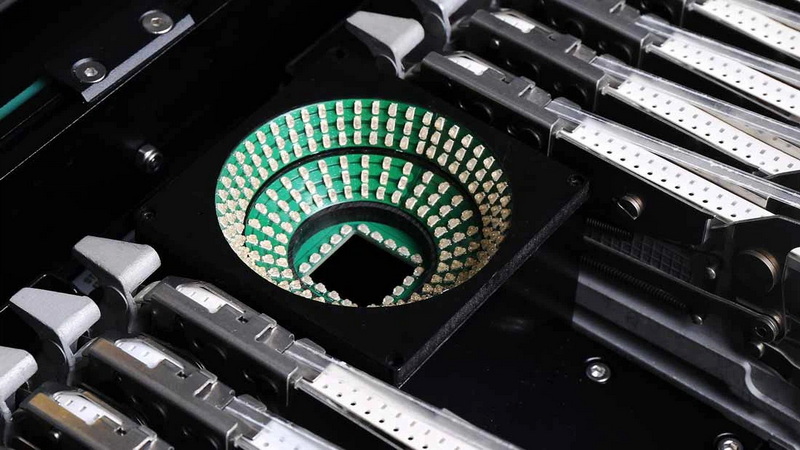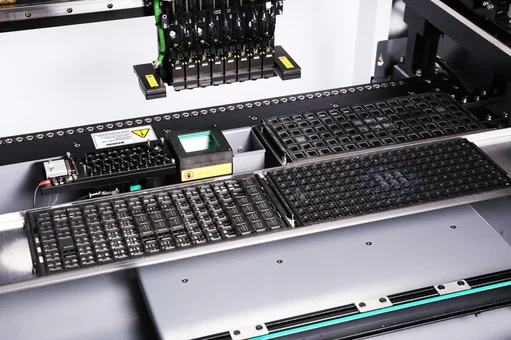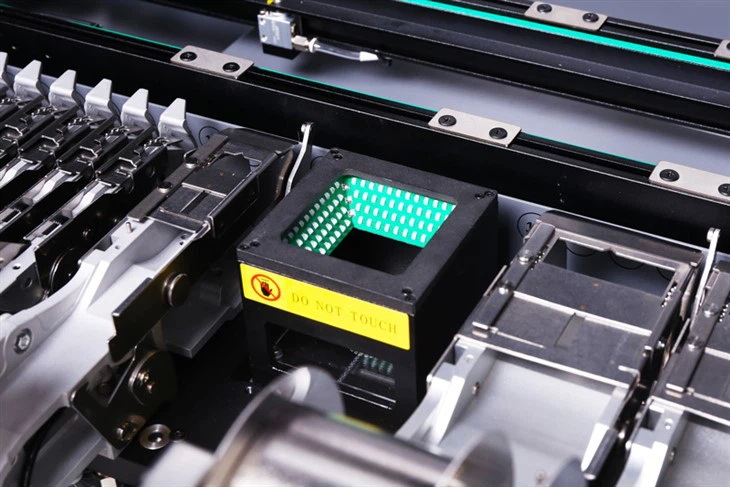Content Menu
● Introduction to SMT SMD Automatic LED Placement Machines
● Core Components of SMT SMD Automatic LED Placement Machines
● Working Principle of SMT SMD Automatic LED Placement Machines
>> 1. Component Loading and Feeder Setup
>> 2. PCB Loading and Alignment
>> 3. Component Pickup
>> 4. Vision Inspection and Correction
>> 5. Component Placement
>> 6. Repetition and Continuous Operation
>> 7. Post-Placement Process
● Features and Advantages of SMT SMD Automatic LED Placement Machines
● Types of SMT SMD Automatic LED Placement Machines
● Operating and Mastering SMT SMD Automatic LED Placement Machines
● Future Trends in SMT SMD Automatic LED Placement Machines
● Conclusion
● FAQ
>> 1. What is the main difference between SMT and SMD in LED placement machines?
>> 2. Can SMT SMD automatic LED placement machines handle different LED sizes?
>> 3. How does the vision system improve placement accuracy?
>> 4. Are SMT SMD automatic LED placement machines capable of soldering?
>> 5. What maintenance is required for these machines?
Surface Mount Technology (SMT) and Surface Mount Devices (SMD) have revolutionized the electronics manufacturing industry by enabling the efficient and precise assembly of electronic components onto printed circuit boards (PCBs). Among the critical equipment in this domain are SMT SMD automatic LED placement machines, which specialize in the rapid and accurate placement of LED components on PCBs. This article explores how these machines work, their components, operating principles, and the benefits they bring to modern electronics manufacturing.

Introduction to SMT SMD Automatic LED Placement Machines
An SMT SMD automatic LED placement machine is a sophisticated piece of industrial equipment designed to pick up LED components and other SMDs and place them precisely onto designated locations on a PCB. These machines automate what was once a painstaking manual process, significantly improving production speed, accuracy, and consistency. They are indispensable in manufacturing LED displays, automotive lighting, consumer electronics, and many other applications where LEDs are used.
The demand for LED products has surged in recent years due to their energy efficiency, long lifespan, and versatility. This surge has driven the need for highly efficient production methods, making SMT SMD automatic LED placement machines central to modern manufacturing lines. Their ability to handle small, delicate components with speed and precision is unmatched by manual assembly.
Core Components of SMT SMD Automatic LED Placement Machines
The operation of an SMT SMD automatic LED placement machine relies on several key components working in harmony:
- Frame and Motion Mechanism: The machine's structure houses the X-Y motion system, typically driven by ball screws and linear guides, which moves the placement head with high precision across the PCB surface. Some machines also include a Z-axis for vertical movement to handle components of varying heights.
- Placement Heads: Equipped with vacuum nozzles, these heads pick up LED components from feeders and place them onto the PCB. Modern machines may have multiple heads working simultaneously to increase throughput. These heads can often rotate to adjust the angle of the component before placement.
- Feeders: These are mechanisms that hold and supply LED components in tape, tray, or tube form, feeding them to the placement heads in the correct orientation. Advanced feeders can automatically load reels and adjust to different component sizes.
- Vision System: Cameras and optical sensors inspect component positions and orientations, as well as PCB alignment marks, enabling real-time adjustments for precise placement. Some machines use multiple cameras for top and side views to ensure component integrity.
- Computer Control System: The brain of the machine, it coordinates all mechanical, optical, and electronic subsystems, executing programmed instructions for placement sequences. It also manages data logging and error reporting.
- PCB Handling System: This system transports the PCB through the machine, ensuring stable positioning during component placement. It often includes conveyors, clamps, and sensors to detect PCB presence and orientation.
Working Principle of SMT SMD Automatic LED Placement Machines
The operation of these machines can be broken down into several sequential steps:
1. Component Loading and Feeder Setup
LED components are loaded into feeders, which are installed on the machine according to the production plan. Each feeder is calibrated to supply components in the correct orientation and sequence, ensuring smooth operation during placement. Proper feeder setup is critical to avoid component jams or misfeeds that could halt production.
2. PCB Loading and Alignment
The PCB is loaded onto the machine's conveyor or platform. The vision system detects fiducial marks on the PCB to accurately determine its position and orientation. This alignment step is crucial to ensure components are placed exactly where the circuit design specifies. Some machines include automated PCB loading and unloading systems to further enhance throughput.
3. Component Pickup
The placement head moves to the feeder location, where a vacuum nozzle picks up an LED component. The vacuum ensures the component is securely held without damage. The nozzle design is optimized to handle the delicate LED surfaces and prevent contamination.
4. Vision Inspection and Correction
Before placement, the vision system inspects the picked component's position and orientation on the nozzle. If any deviation is detected, the machine automatically adjusts the placement head's position and angle to correct it. This closed-loop feedback system dramatically improves placement accuracy and reduces defects.
5. Component Placement
The placement head moves to the designated location on the PCB and places the LED component with precise pressure and positioning. The solder paste previously applied on the PCB pads acts as a temporary adhesive. The machine controls placement speed and pressure to avoid damaging sensitive LED components.
6. Repetition and Continuous Operation
This process repeats rapidly for all components on the PCB. Machines with multiple placement heads and feeders can handle complex boards with thousands of components efficiently. Some machines are capable of simultaneous multi-head placement, which significantly increases throughput.
7. Post-Placement Process
After placement, the PCB typically moves to a reflow soldering oven where the solder paste melts and solidifies, creating strong electrical and mechanical connections. The quality of placement directly impacts the soldering process and the final product reliability.

Features and Advantages of SMT SMD Automatic LED Placement Machines
- High Speed and Efficiency: These machines can place tens of thousands of components per hour, significantly faster than manual assembly. This speed is essential for meeting the demands of mass production.
- Precision and Accuracy: Vision systems and high-precision mechanical parts ensure placement accuracy within microns, critical for modern miniaturized electronics. This precision reduces defects and rework costs.
- Flexibility: Capable of handling various LED sizes and shapes, as well as other SMD components, enabling versatile production lines. Changeover between different products is often quick, thanks to programmable feeders and placement heads.
- Automation and Reduced Labor: Automation reduces human error and labor costs, improving overall production quality and consistency. Operators can focus on machine supervision and maintenance rather than manual placement.
- Scalability: Suitable for small prototype runs to large-scale mass production, these machines can adapt to different production volumes and complexities.
- Data Integration: Modern machines often include software that integrates with factory management systems, enabling real-time monitoring, traceability, and analytics.
Types of SMT SMD Automatic LED Placement Machines
- Pick and Place Machines: The most common type, using robotic arms and vacuum nozzles to pick components from feeders and place them on PCBs. They offer high flexibility and precision.
- Gantry-Style Machines: Use a gantry system with cameras for component identification and placement, often used for high-precision applications. These machines are ideal for complex PCB assemblies.
- Hybrid Machines: Combine placement and soldering functions in one system, useful for mixed technology assemblies where both SMT and through-hole components are used.
- Manual and Semi-Automatic Machines: For small-scale or prototyping work, these require more operator involvement but offer lower cost and simpler operation.
Operating and Mastering SMT SMD Automatic LED Placement Machines
Effective operation involves several critical steps:
- Machine Setup and Calibration: Properly installing feeders, calibrating vision systems, and aligning the placement heads. This ensures the machine operates within specified tolerances.
- Programming: Loading the PCB design and component placement data into the machine's control software. This includes defining component types, positions, orientations, and feeder assignments.
- Monitoring: Continuous supervision of placement accuracy and machine status to detect and correct errors. Many machines include alarms and automatic stop functions for fault conditions.
- Maintenance: Regular cleaning, nozzle replacement, and mechanical checks to ensure consistent performance. Preventive maintenance reduces downtime and prolongs machine life.
- Training: Skilled operators and technicians are essential to maximize machine efficiency and troubleshoot issues promptly.
Future Trends in SMT SMD Automatic LED Placement Machines
As electronics continue to miniaturize and production demands increase, SMT SMD automatic LED placement machines are evolving in several ways:
- Artificial Intelligence and Machine Learning: Integration of AI algorithms to optimize placement sequences, detect defects, and predict maintenance needs.
- Enhanced Vision Systems: Use of 3D vision and advanced image processing for even greater placement accuracy and component inspection.
- Increased Automation: Fully automated production lines with robotic PCB loading/unloading and inline inspection systems.
- Multi-Function Machines: Equipment capable of handling multiple assembly processes, including placement, soldering, and testing, in a single platform.
- Sustainability: Development of machines that reduce energy consumption and material waste, supporting greener manufacturing practices.
Conclusion
SMT SMD automatic LED placement machines are vital tools in modern electronics manufacturing, enabling the rapid, precise, and efficient assembly of LED components on PCBs. Their integration of advanced mechanical systems, vision technology, and computer control allows manufacturers to meet the increasing demands for quality and speed in LED product assembly. As technology advances, these machines continue to evolve, offering even greater capabilities and flexibility to support the growing LED industry. Mastery of these machines, combined with proper maintenance and programming, ensures optimal performance and high-quality production outcomes.

FAQ
1. What is the main difference between SMT and SMD in LED placement machines?
SMT refers to the technology of mounting components directly onto the PCB surface, while SMD refers to the components themselves designed for surface mounting. SMT SMD automatic LED placement machines use SMT technology to place SMD LED components accurately on PCBs.
2. Can SMT SMD automatic LED placement machines handle different LED sizes?
Yes, these machines are designed to accommodate a wide range of LED sizes and package types, from very small 0201 packages to larger components, by adjusting the placement heads and feeders accordingly.
3. How does the vision system improve placement accuracy?
The vision system detects the exact position and orientation of components and PCB fiducial marks, allowing the machine to make real-time adjustments to the placement head, ensuring components are placed precisely as programmed.
4. Are SMT SMD automatic LED placement machines capable of soldering?
No, these machines only place components. Soldering is typically done afterward in a reflow oven, where the solder paste melts and solidifies to secure the components electrically and mechanically.
5. What maintenance is required for these machines?
Regular maintenance includes cleaning nozzles and feeders, checking vacuum systems, calibrating vision cameras, and inspecting mechanical parts to prevent wear and ensure consistent placement accuracy.




















